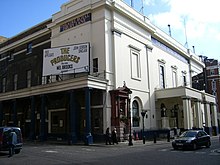This is an old revision of this page, as edited by Bunchofgrapes (talk | contribs) at 02:43, 28 March 2006 (Start a history section for the 1663 incarnation of the theatre). The present address (URL) is a permanent link to this revision, which may differ significantly from the current revision.
Revision as of 02:43, 28 March 2006 by Bunchofgrapes (talk | contribs) (Start a history section for the 1663 incarnation of the theatre)(diff) ← Previous revision | Latest revision (diff) | Newer revision → (diff)

from Russell Street and Catherine Street
The Theatre Royal, Drury Lane is a theatre in the West End area of London, officially situated on Catherine Street, but backing onto Drury Lane just to the east of Covent Garden.
A cockpit in that location was converted into a theatre during the reign of James I. After the Restoration of the monarchy in 1660, a splendid new theatre was built to designs by Christopher Wren. Having been razed by fire on January 25 1672, it was succeeded by a larger and still more elaborate building also designed by Wren, which housed two thousand spectators with the opening attended by Charles II on March 26 1674.
The great English actor David Garrick managed the theatre during the mid-eighteenth century, during which time he produced many plays, including most of Shakespeare's work.
By the end of the 18th century, the building was in need of updating, and was demolished in 1791. A third theatre was designed by Henry Holland and opened on March 12 1794, lasting for only 15 years before burning down on February 24 1809.
The present Theatre Royal in Drury Lane, designed by Benjamin Wyatt, opened on October 10 1812 with a production of Hamlet. The interior has been substantially redesigned and overhauled many times since then: a contemporary sketch of it when it was new is shown on the right, seen from the point of view of the beau monde in the lower gallery. It is one of the West End's largest, and has been the setting for appearances by Edmund Kean and Sarah Siddons, among others.
With a capacity of 2,205, it has been home to many large productions over the years. It is currently showing a revival of Mel Brooks' musical The Producers.
1663-1672
Charles II returned to the English Throne in 1660 after the decade-long Puritan Interregnum, which had seen the banning of such frivolous pastimes as theatre. It was not long after this Restoration that Charles issued patents to two parties licensing the formation of new acting companies. One of these went to Thomas Killigrew, whose company would become known as the King's Company, and who would build a new theatre in Drury Lane. This playhouse, designed by Christopher Wren, opened on May 7 1663. It was a three-tiered wooden structure, 112 feet long and 59 feet wide; it could hold 700 audience members.
Principal recent productions
- Pirates of Penzance (May 26, 1982 - October 29, 1983)
- 42nd Street (August 8, 1984 - January 7, 1989)
- Miss Saigon (September 20, 1989 - October 30, 1999)
- The Witches of Eastwick (July 18, 2000 - February 24, 2001)
- My Fair Lady (July 21, 2001 - August 30, 2003)
- Anything Goes (October 7, 2003 - August 28, 2004)
- The Producers (November 9, 2004 - )
Nearby Tube Stations
Notes
- Beauclerk, Charles (2005). Nell Gwyn: Mistress to a King. Atlantic Monthly Press. ISBN 0-87113-926-X. pp 59–60.